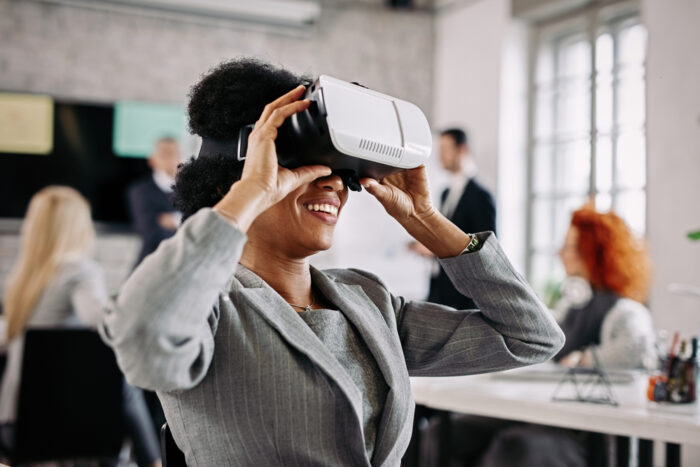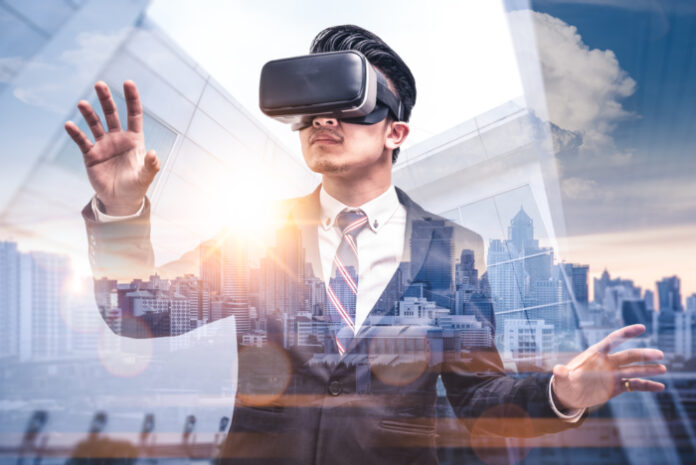- Overview of VR and AR Technologies
- Importance in the marketing landscape
Imagine browsing a clothing store online. You can see how the clothes look on you before making a purchase. Or, you could envision attending a virtual product launch. This would allow you to explore a new gadget in a fully immersive environment.
This is the power of virtual reality (VR) and augmented reality (AR) technologies in marketing. Augmented Reality (AR) overlays computer-generated content in the real world, while Virtual Reality (VR) is a fully immersive digital experience in a simulated environment.
In 2023, these technologies will continue to play a vital role in enhancing customer experiences and driving sales. Let’s explore the importance of VR and AR in the marketing landscape and understand how they shape commerce’s future.
1. Immersive Brand Experiences
To connect with customers on a deeper level, provide an immersive brand experience that goes beyond traditional marketing. This helps customers see how your product can solve their problems or meet their requirements. Virtual and augmented reality are great tools for creating immersive experiences that leave lasting impressions.
A particularly exciting use case is the Metaverse, wherein you can have a 3D avatar; virtual legal address; lifelike assets, from cars to paintings. Brands can create deeply immersive experiences given this malleable environment.
Benefits
These technologies enable customers to visualize your product or service and see firsthand how it can solve their problems. By doing so, you can foster a deeper connection with your customers and enjoy the following benefits:
- Increased Customer Engagement
In marketing, virtual reality (VR) and augmented reality (AR) can capture customer attention and encourage them to interact with your brand for longer. By offering an interactive and unique brand experience, these technologies can result in higher conversion rates and better customer retention.
- Memorable Branding
VR and AR provide an opportunity to create a distinctive and memorable brand experience. With these technologies, you can showcase your brand in an unforgettable way. Customers are more likely to remember your brand and share their experiences with others, increasing brand awareness and word-of-mouth marketing. The emotional connection created by VR and AR can also increase customer loyalty. This can further help differentiate your brand from competitors and increase customer loyalty.
Examples
Here are some real-life examples of how brands are using VR and AR to create engaging experiences for their customers:
- Virtual Product Demonstrations
Using VR and AR, brands can create virtual product demonstrations that give customers a realistic experience of using the product. For instance, IKEA uses AR to let customers see how furniture items would look in their homes. The app overlays digital images of the furniture on the user’s camera view, allowing them to visualize how it would fit in their space. Similarly, automobile manufacturers like Audi and Mercedes-Benz use VR to give customers a virtual test drive of their cars, complete with realistic sounds and movements.
- Interactive Brand Events
In 2019, Nike launched an AR-powered pop-up store in Tokyo, allowing customers to see life-sized 3D models of their favorite sneakers. Users could customize the sneakers with different colors and patterns before purchasing them. Another example is the Coachella Valley Music and Arts Festival, which has used AR to create immersive experiences like a virtual tour of the festival grounds and an interactive art installation.
2. AR-Enhanced E-commerce
According to a recent study by Global News Wire, AR-enhanced e-commerce is proving to be a game-changer in online shopping. The study found that 60% of US adults are more likely to purchase a product if it is shown in 3D or AR.
This highlights the potential for retailers to capitalize on AR technology and enhance the shopping experience for their customers. In this section, we will explore the benefits of AR-enhanced e-commerce and show businesses how they can implement this technology into their operations.
Advantages
Using augmented reality (AR) in your e-commerce marketing strategy can offer several advantages to your business. By incorporating AR technology, you can take your customers’ shopping experience to a new level. Here are some benefits of AR-enhanced e-commerce:
- Improved Product Visualization
With the help of AR, customers can now visualize how a product would look in their real environment before making a purchase. This feature enhances their shopping experience and helps them make informed decisions. They can now view the product’s features, size, color, and texture more accurately, making them feel more confident purchasing.
- Increased Conversion Rates
Using AR in e-commerce can significantly increase conversion rates. According to Shopify data, products with AR content had a 94% higher conversion rate than those without AR. This is because AR allows customers to see and experience products virtually. This gives them a more realistic and accurate representation of the product. This leads to increased confidence in the product and a higher likelihood of purchasing.
Implementations
- Virtual Fitting Rooms
AR can create virtual fitting rooms where customers can see themselves in the product, even before purchasing. This can help customers make more informed decisions and reduce the likelihood of returns. Virtual fitting rooms can also allow retailers to suggest complementary items, improving the customer experience.
- 3D product previews
AR can be used to create a 3D representation of a product. This allows customers to rotate and view it from different angles. For example, furniture companies can use AR to create a virtual model of a sofa and show customers how it would look in their living room. Similarly, makeup brands can use AR to show customers how a particular shade of lipstick would look on their lips. This immersive experience can enhance customer engagement and boost sales.

3. VR and AR Advertising
In 2023, revenue in the VR-AR Advertising segment is projected to reach USD 31.12 bn. This indicates that businesses are increasingly recognizing their potential in marketing. VR and AR advertising offers a unique opportunity to grow your business in an immersive manner.
Overview
To fully leverage the potential of VR and AR Advertising, businesses need to focus on creating immersive ad formats that offer increased user interaction. Here are two key points to consider:
- Immersive Ad Formats
Immersive ad formats are becoming more popular, allowing consumers to experience products and services in a virtual environment. For example, a food and beverage brand could create a pop-up restaurant in a VR space. And allow the customers to taste their products and uniquely interact with the brand. Similarly, many industries, like home decor companies, are experimenting with immersive ad formats. These companies allow customers to decorate their living spaces virtually.
- Increased User Interaction
In traditional ads, users passively consume the content. However, AR and VR ads offer increased user interaction, allowing them to engage more actively and effectively with the brand. AR can bring products to life through virtual try-ons, while VR can transport users to a different world where they can experience the brand’s message firsthand. This increased user interaction leads to a more memorable and impactful advertising experience.
Examples
- Branded VR experiences
- AR-based social media filters
One example of branded VR experiences that have been successful in marketing is Red Bull’s VR simulator. It immerses users in a thrilling extreme sports experience. The simulator takes users on a virtual ride on a roller coaster. It gives them the sensation of being a part of a Red Bull extreme sports event.
Another example of AR and VR in marketing is AR-based social media filters. Brands can create custom AR filters that users can apply to their photos and videos on platforms like Instagram and Snapchat. For example, Coca-Cola created an AR filter that allowed users to turn themselves into polar bears to promote their holiday campaign.
This marketing strategy allows brands to reach a wider audience through user-generated content while creating a fun and engaging experience for their customers.
4. Gamification and Branded Games
Gamification and branded games are two popular methods of using virtual reality (VR) and augmented reality (AR) in marketing. They help you tap into human emotions, encourage participation, and promote brand loyalty. Businesses can drive customer engagement and boost brand awareness by infusing play and competition into marketing strategies.
Importance
Gamification and branded games, in particular, help brands stand out from the competition.
Gamification refers to using game elements, such as point-scoring systems or leaderboards. It makes marketing more interactive and engaging. On the other hand, branded games are fully-fledged games designed to promote a specific brand or product.
Integrating gamification and branded games with AR and VR creates an even more immersive customer experience. This can lead to a range of benefits for businesses:
- Entertaining and Engaging Marketing
Gamification and Branded Games can make your marketing campaigns more fun and interactive. For example, McDonald’s Frylus game, launched in 2019, encouraged customers to use their phone’s camera to take a selfie with a virtual french fry and share it on social media. The game was a hit and helped McDonald’s to increase their social media engagement and brand awareness.
- Increased Brand Awareness
Gamification and Branded Games can also be effective in increasing brand awareness. By creating a fun and engaging game, companies can encourage customers to share the game on social media, increasing brand exposure. For example, the “Share a Coke” campaign by Coca-Cola urged customers to share photos of themselves with personalized Coke bottles on social media, which led to a viral campaign and increased brand awareness.
Examples
Numerous VR/AR-based brand games and gamification examples have been developed to promote various products and services.
- VR/AR-Based Brand Games
A great example is the “Nike Run Club” app for gamification. It uses gamification to motivate users to run by setting challenges, giving rewards, and creating a sense of community. The app tracks users’ runs and provides feedback, making it more engaging and immersive.
For branded games, a notable example is “Lego AR Studio.” This app allows users to create virtual Lego models in their real-world environment using AR. It offers Lego fans a unique and engaging experience, promoting the brand interactively and memorably.
- Interactive promotions
Interactive promotions are another effective way to use VR and AR in marketing. For gamification, a great example is “Snapchat’s AR Lens.” This feature allows brands to create custom AR filters that users can apply to their selfies, distinctly promoting the brand.
“Coca-Cola’s Happiness Factory” is an excellent example of branded games. This game takes players on a virtual tour of Coca-Cola’s bottling factory, promoting the brand in an immersive way. It also includes interactive elements, allowing players to customize and share their virtual factory on social media.

5. Location-Based Marketing
Virtual reality (VR) and augmented reality (AR) are changing the face of marketing. And their influence is only set to grow in 2023. Location-based marketing is one area where these technologies have a significant impact, allowing marketers to target promotions and integrate them into the real world.
Advantages
The advantages of location-based marketing using VR and AR are significant.
- Targeted Promotions
Firstly, it allows for targeted promotions tailored to each consumer’s individual needs. Using GPS technology and other location-based data, marketers can identify consumers in a particular location and offer them promotions that are most likely to interest them. This level of personalization ensures that the promotions are relevant and timely, leading to a higher conversion rate.
- Real-World Integration
One of the main advantages of using AR and VR in location-based marketing is the ability to integrate real-world elements into the experience seamlessly. This means you can enhance the physical environment with digital elements, creating a more immersive and engaging experience for your customers.
For example, you can use AR to place virtual objects in specific locations, such as a virtual pop-up shop in a park or a digital billboard on a busy street corner. This allows you to create a unique and memorable experience that will stick with your customers long after they leave the physical location.
By leveraging AR and VR in location-based marketing, you can take your campaigns to the next level and truly stand out.
Examples
- AR-Enhanced Store Navigation
AR-Enhanced Store Navigation allows you to navigate through the store with ease. Imagine walking into a store and using your phone to scan a QR code. Your phone will show you a store map highlighting each item’s location. Walking through the store, you can see where you are on the map and the location of the things you want to purchase. This makes your shopping experience more efficient, saving you time and making it easier to find what you need. Adidas has already implemented AR-Enhanced Store Navigation in their London flagship store, allowing customers to quickly locate items and see product information.
- Geolocation-Triggered Offers
Geolocation-Triggered Offers to use your location to give you personalized offers. Imagine walking by a store and receiving a notification on your phone for a special offer just for you. This offer is only available to customers within a certain distance from the store. This creates a sense of urgency and encourages you to take advantage of the offer. Starbucks has already implemented Geolocation-Triggered Offers through their app, sending personalized offers to customers when they are near a Starbucks location. This allows them to attract customers who may not be considering visiting Starbucks.
Conclusion
- Recap of VR and AR applications in marketing
- Importance of embracing emerging technologies
- Encouragement to explore innovative marketing strategies
In conclusion, Virtual Reality (VR) and Augmented Reality (AR) are becoming increasingly crucial in marketing. They provide immersive experiences that traditional marketing methods cannot match. Using these technologies, you, including increased cust using these technologies over engagement, memorable branding, improved product visualization, and increased conversion rates.
Some popular companies like IKEA, Audi, Mercedes-Benz, and Nike are already using these technologies to offer interactive experiences to their customers. Therefore, your business must embrace emerging technologies like VR and AR and explore innovative marketing strategies to remain competitive and appeal to customers. Doing so can create unique and unforgettable customer experiences, drive sales, and increase brand loyalty.
Find a Home-Based Business to Start-Up >>> Hundreds of Business Listings.















































